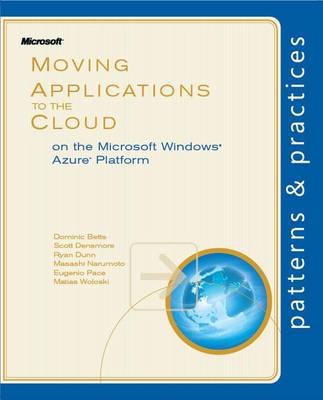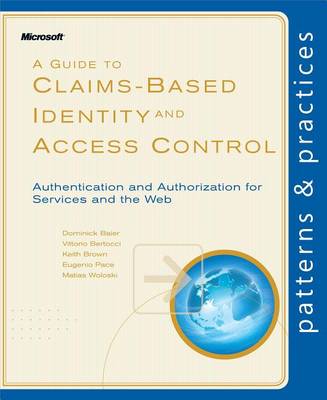Patterns & Practices
2 total works
Moving Applications to the Cloud on the Microsoft Azure Platform
by Eugenio Pace, Dominic Betts, Scott Densmore, Ryan Dunn, Masashi Narumoto, and Matias Woloski
Published 1 August 2010
How can a company's applications be scalable and have high availability? To achieve this, along with developing the applications, you must also have an infrastructure that can support them. For example, you may need to add servers or increase the capacities of existing ones, have redundant hardware, add logic to the application to handle distributed computing, and add logic for failovers. You have to do this even if an application is in high demand for only short periods of time. Life becomes even more complicated (and expensive) when you start to consider issues such as network latency and security boundaries. The cloud offers a solution to this dilemma. The cloud is made up of interconnected servers located in various data centers. However, you see what appears to be a centralized location that someone else hosts and manages. By shifting the responsibility of maintaining an infrastructure to someone else, you're free to concentrate on what matters most: the application. If the cloud has data centers in different geographical areas, you can move your content closer to the people who are using it most.
If an application is heavily used in Asia, have an instance running in a data center located there. This kind of flexibility may not be available to you if you have to own all the hardware. Another advantage to the cloud is that it's a pay as you go proposition. If you don't need it, you don't have to pay for it. When demand is high, you can scale up, and when demand is low, you can scale back. Yes, by moving applications to the cloud, you're giving up some control and autonomy, but you're also going to benefit from reduced costs, increased flexibility, and scalable computation and storage. The Windows Azure Architecture Guide shows you how to do this.
If an application is heavily used in Asia, have an instance running in a data center located there. This kind of flexibility may not be available to you if you have to own all the hardware. Another advantage to the cloud is that it's a pay as you go proposition. If you don't need it, you don't have to pay for it. When demand is high, you can scale up, and when demand is low, you can scale back. Yes, by moving applications to the cloud, you're giving up some control and autonomy, but you're also going to benefit from reduced costs, increased flexibility, and scalable computation and storage. The Windows Azure Architecture Guide shows you how to do this.
A Guide to Claims-Based Identity and Access Control
by Dominick Baier, Vittorio Bertocci, Professor Keith Brown, Matias Woloski, and Eugenio Pace
Published 1 April 2010
As systems have become interconnected and more complicated, programmers needed ways to identify parties across multiple computers. One way to do this was for the parties that used applications on one computer to authenticate to the applications (and/or operating systems) that ran on the other computers. This mechanism is still widely used-for example, when logging on to a great number of Web sites. However, this approach becomes unmanageable when you have many co-operating systems (as is the case, for example, in the enterprise). Therefore, specialized services were invented that would register and authenticate users, and subsequently provide claims about them to interested applications. Some well-known examples are NTLM, Kerberos, Public Key Infrastructure (PKI), and the Security Assertion Markup Language (SAML). Most enterprise applications need some basic user security features. At a minimum, they need to authenticate their users, and many also need to authorize access to certain features so that only privileged users can get to them. Some apps must go further and audit what the user does.
On Windows(R), these features are built into the operating system and are usually quite easy to integrate into an application. By taking advantage of Windows integrated authentication, you don't have to invent your own authentication protocol or manage a user database. By using access control lists (ACLs), impersonation, and features such as groups, you can implement authorization with very little code. Indeed, this advice applies no matter which OS you are using. It's almost always a better idea to integrate closely with the security features in your OS rather than reinventing those features yourself. But what happens when you want to extend reach to users who don't happen to have Windows accounts? What about users who aren't running Windows at all? More and more applications need this type of reach, which seems to fly in the face of traditional advice. This book gives you enough information to evaluate claims-based identity as a possible option when you're planning a new application or making changes to an existing one.
It is intended for any architect, developer, or information technology (IT) professional who designs, builds, or operates Web applications and services that require identity information about their users.
On Windows(R), these features are built into the operating system and are usually quite easy to integrate into an application. By taking advantage of Windows integrated authentication, you don't have to invent your own authentication protocol or manage a user database. By using access control lists (ACLs), impersonation, and features such as groups, you can implement authorization with very little code. Indeed, this advice applies no matter which OS you are using. It's almost always a better idea to integrate closely with the security features in your OS rather than reinventing those features yourself. But what happens when you want to extend reach to users who don't happen to have Windows accounts? What about users who aren't running Windows at all? More and more applications need this type of reach, which seems to fly in the face of traditional advice. This book gives you enough information to evaluate claims-based identity as a possible option when you're planning a new application or making changes to an existing one.
It is intended for any architect, developer, or information technology (IT) professional who designs, builds, or operates Web applications and services that require identity information about their users.

